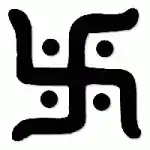In Naruto, the Hyūga clan is divided into two houses: the main house and the branch house.
The main house members brand the branch house members with a Juinjutsu (Cursed mark), which has the objective of sealing away the Byakugan upon the death of the one branded. It also has the function of controlling the branch house members through the destruction of the wearer's brain cells, which can be activated by a hand seal only known by the main house members.
The seal looks like this:

Although the Hyūga Main Family's Juinjutsu was altered in the anime for its resemblance with a swastika (and the connotation with the Nazi regime), the manga version maintains its original design.
Quoting directly from Wikipedia:
The word "swastika" comes from the Sanskrit swastika - "su" meaning "good," "asti" meaning "to be," and "ka" as a suffix. The swastika literally means "to be good". Or another translation can be made: "swa" is "higher self", "asti" meaning "being", and "ka" as a suffix, so the translation can be interpreted as "being with higher self".
Both these translations would fit (at least according to my interpretation) the secondary purpose of the Juinjutsu:
- To be good: the secondary function of the Juinjutsu is to control the branch house members, which is to 'make them good' (at least to make them submit themselves to the main house members' will).
- Being with higher self: the Juinjutsu links the branch house members ('lower self') with the main house members ('higher self').
Are there any canon sources that state:
If this resemblance is purely coincidental? Or if the seal is really a swastika?
 .
.